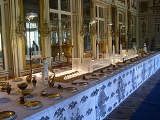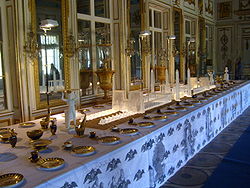
Egyptian revival decorative arts
Encyclopedia
Egyptian revival decorative arts is an early nineteenth century movement in which Egyptian motifs were applied to a wide variety of Decorative arts objects.
 Enthusiasm for the artistic style of Ancient Egypt is generally attributed to the excitement over Napoleon's conquest of Egypt and, in Britain, to Admiral Nelson's defeat of Napoleon at the Battle of the Nile in 1798. Napoleon took a scientific expedition with him to Egypt. Publication of the expedition's work, the Description de l'Égypte, began in 1809 and came out in a series though 1826, inspiring everything form sofas with Sphinxes for legs to tea sets painted with the pyramids. It was the popularity of the style that was new, Egyptianizing works of art had appeared in scattered European settings from the time of the Renaissance.
Enthusiasm for the artistic style of Ancient Egypt is generally attributed to the excitement over Napoleon's conquest of Egypt and, in Britain, to Admiral Nelson's defeat of Napoleon at the Battle of the Nile in 1798. Napoleon took a scientific expedition with him to Egypt. Publication of the expedition's work, the Description de l'Égypte, began in 1809 and came out in a series though 1826, inspiring everything form sofas with Sphinxes for legs to tea sets painted with the pyramids. It was the popularity of the style that was new, Egyptianizing works of art had appeared in scattered European settings from the time of the Renaissance.
The Egyptian Gallery, a private room in the home of connoisseur Thomas Hope to display his Egyptian antiquities, and illustrated in engravings from his meticulous line drawings in his Household Furniture and Interior Decoration (1807), were a prime source for the Regency style in British furnishings. His book Household Furniture and Interior Decoration, inspired a generation of fashionable English homeowners to install parlor suites featuring chairs, tables and sofas in shapes that evoked the objects depicted on Egyptian tomb paintings.

The Egyptian Gallery, a private room in the home of connoisseur Thomas Hope to display his Egyptian antiquities, and illustrated in engravings from his meticulous line drawings in his Household Furniture and Interior Decoration (1807), were a prime source for the Regency style in British furnishings. His book Household Furniture and Interior Decoration, inspired a generation of fashionable English homeowners to install parlor suites featuring chairs, tables and sofas in shapes that evoked the objects depicted on Egyptian tomb paintings.
Sources
- Egyptomania; Egypt in Western Art; 1730-1930, Jean-marcel Humbert, Michael Pantazzi and Christiane Ziegler, 1994
- The Egyptian revival : its sources, monuments, and meaning, 1808-1858, Richard G. Carrott, 1978
- The Egyptian Revival: Ancient Egypt as the Inspiration for Design Motifs in the West, James Stevens Curl, 2005
- Household Furniture and Interior Decoration, Thomas Hope, 1807

